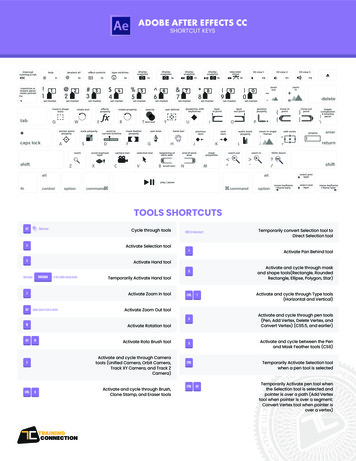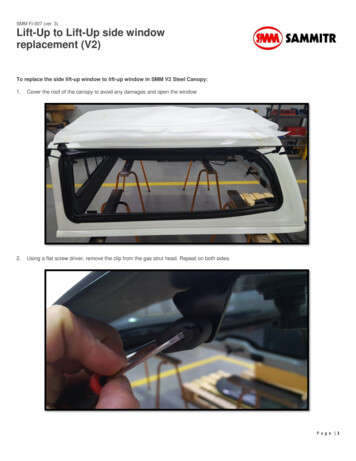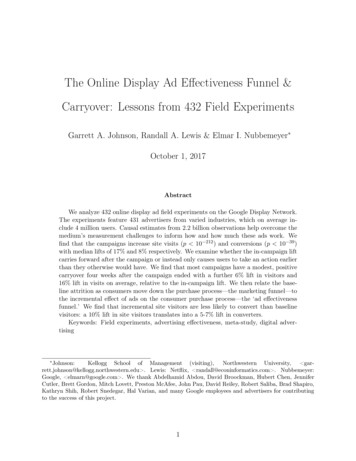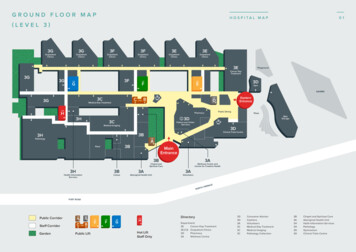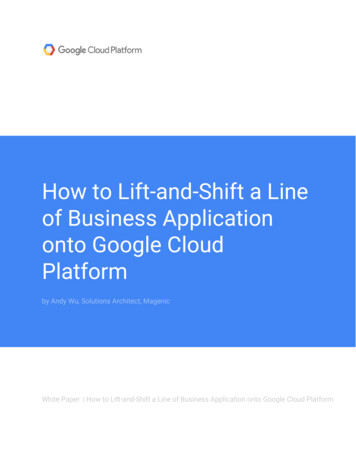
Transcription
How to Lift-and-Shift a Lineof Business Applicationonto Google CloudPlatformby Andy Wu, Solutions Architect, MagenicWhite Paper How to Lift-and-Shift a Line of Business Application onto Google Cloud Platform
Table of ContentsScenario Description3Background Information3Project Approach3Current On-Premises System Architecture4Final Targeted On-Cloud System Architecture4The How-Tos5Phase One Implementation5Creating a GCP network5Creating the Site-to-Site VPN5Creating the VMs to Support the On-Cloud System Architecture6Code DeploymentEncryption of Sensitive Data as part of Deployment ProcessPhase TwoCreating the SQL Server AlwaysOn Availability GroupsPhase ThreeSetting up the AD Replication for Redundancy in the Cloud91010101111On the on-premises DC12On the GCP AD DC16Final Thoughts and Conclusion21 2017 Google Inc. All rights reserved. Google and the Google logo are trademarks of Google Inc. All other company and product names may be trademarks ofthe respective companies with which they are associated.2
GitHub Source Url: https://github.com/Magenic/GCELiftAndShiftScenario DescriptionMagenicons, a fictional comic book publishing company, has decided that its IT infrastructure needsto go through a modernization effort to increase system reliability while providing cost savings. Its ITstaff believes leveraging cloud computing will help the company gain better agility for its ITinfrastructure and applications. As part of an evaluation process, the company has selected anexisting intranet-based expense reporting application as the proof-of-concept for its cloud migrationstrategy.Background InformationThe expense reporting application is a standard two-tier web-based application that currently relies onan on-premises Microsoft Internet Information Server (IIS) server with data storage on a separateon-premises Microsoft SQL Server. A second on-premises IIS server also provides auditing services.Access to the application is secured by authenticating against an on-premises Active Directory (AD)instance while data access is secured by using SQL Server Authentication with an application serviceaccount.Project ApproachIn order to minimize risk while gradually ramping up its teams’ cloud knowledge and experience,Magenicons wants to execute the project in phases, with each phase having a defined objective toachieve. These objectives will be used at the end of the project for evaluation of the long-term viabilityof cloud computing for the company. Google Cloud Platform (GCP) was selected as the cloudprovider due to the robust capabilities of the platform and Google’s excellent technical reputation. Phase one – Migrate the application to the cloud using Google’s Infrastructure-as-a-Service(IaaS) offering, Google Compute Engine.o Objective: Lift-and-shift the expense reporting application by leveraging ComputeEngine with minimal cost. In particular, the company would like to execute the movewith minimal to no code change to the existing application.o Prerequisite: Environment setup, such as establishing a network connection betweenMagenicons’ local network and GCP, will be required in this phase to support thelift-and-shift of the application. Phase two – Leverage the cloud for high availability (HA).o Objective: Once the application is properly operating in the cloud, Magenicons wouldlike to reduce the risk of potential downtimes by adding high availability to SQL Serverused by the application. AlwaysOn Availability Groups is SQL Server’s recommendedsolution, allowing users to configure replicas for automatic failover in case of failure.GCP supports Windows Server Failover Clustering (WSFC) and SQL ServerAlwaysOn Availability Groups. Phase three – Leverage the cloud for disaster recovery (DR)o Objective: Magenicons would like to then further enhance application availability and 2017 Google Inc. All rights reserved. Google and the Google logo are trademarks of Google Inc. All other company and product names may be trademarks ofthe respective companies with which they are associated.3
improve its DR plan by extending their on-premises AD into the cloud. This provides acost-effective option for protecting AD in DR scenarios. In the event of a physicaldisaster or outage at company’s data center, a virtual machine (VM) running as anActive Directory Domain Controller (AD DC) in GCP can provide uninterrupted accessto AD for cloud-based applications and any on-premises AD-integrated applicationsunaffected by the outage. As an added benefit, having an AD hosted in the cloudalongside the application will generally shorten the network latency and thus improvesystem response time.Current On-Premises System ArchitectureThe expense report system uses a standard ASP.NET MVC application architecture for an intranetenvironment. The application is deployed onto an IIS webserver hosted in Windows Server and joinedto the AD domain. The system is secured by leveraging Windows Integrated Security for all access tothe application. Connection to SQL Server is also quite standard by using SQL Server Authenticationwith a domain service account user id and password.Final Targeted On-Cloud System ArchitectureThe final targeted system architecture should look similar to the original on-premises systemarchitecture, as it is treating GCP as an extension to the on-premises data center via a virtual privatenetwork (VPN) with additional features for SQL Server HA and DR for AD. 2017 Google Inc. All rights reserved. Google and the Google logo are trademarks of Google Inc. All other company and product names may be trademarks ofthe respective companies with which they are associated.4
The How-TosPhase One ImplementationFor the phase-one objective of lifting-and-shifting the expense reporting application to the cloud, threemajor tasks were identified as requirements:1.2.3.4.Create a GCP network suitable for the projectCreate a VPN from the Magenicons corporate network to GCPCreate the VM instances that are necessary to support the applicationMake any necessary configuration and or code changes to support the lift-and-shiftCreating a GCP networkGCP networks connect VM instances to each other and to the Internet, allowing users to segmenttheir networks, create firewall rules for access control as well as create static routes to forward trafficto specific destinations. All of these capabilities will be needed as the project moves along its variousphases. A tutorial on the particulars of GCP networking can be found here .Important Note: Any type of supported subnet network mode (auto or custom) can be used toachieve phase one’s objectives. However, as detailed in phase two below, in order to install SQLServer AlwaysOn Availability Groups a custom subnet must be used. Therefore, if one has the desireto eventually install this feature, it is highly recommended that a custom subnet be created for theproject from the beginning to avoid any unnecessary rework down the road.Creating the Site-to-Site VPNCreating the VPN was a straightforward exercise and the project team did not run into any issues of 2017 Google Inc. All rights reserved. Google and the Google logo are trademarks of Google Inc. All other company and product names may be trademarks ofthe respective companies with which they are associated.5
note. They simply followed the Google documentation and the VPN was up and running within a day.Creating the VMs to Support the On-Cloud System ArchitectureCreating VM instances in Compute Engine can be done in three ways:1. The point-and-click interface: Google Cloud Console in the subscriber’s portal2. REST API3. Command Line Interface (CLI), which in Google’s case is called the gcloud command lineinterfaceSince the team understands that automation is a key ingredient to long term sustainability for cloudcomputing, it decided that a code-based approach using the gcloud command line interface would bethe preferred choice.Using the CLI is quite simple—just download the gcloud command line interface from Google andfollow the documentation . Below is a screenshot of the experience when creating a Windows ServerInstance:Below are the VM instances and their roles needed for the various phases of the project: Phase 1o IIS Web Servero SQL ServerPhase 2o Additional SQL Server instance used as part of SQL Server Availability Group replicaPhase 3o An AD Domain Controller instance running in GCP with full replication to the 2017 Google Inc. All rights reserved. Google and the Google logo are trademarks of Google Inc. All other company and product names may be trademarks ofthe respective companies with which they are associated.6
on-premises instance of AD Domain ControllerIn addition to the above mentioned VM creation methods, GCP offers another great time-savingalternative for creating VM instances: Google Cloud Launcher. Google Cloud Launcher is amarketplace for third party ready-to-go development stacks, solutions and services. If the workloadtype fits what’s available, then one can create the needed VM with simply a few clicks.For Phase 1 development, the staff needed an IIS Server with ASP.NET 4.6 and its supporting .NETFramework installed. With the usual VM creation method, one would have to create the OS VM, andmanually install all the various .NET Framework & ASP.NET component. With Cloud Launcher forASP.NET, however, the process is dramatically simplified:1. Go to the following url: https://console.cloud.google.com/launcher2. Type in asp.net in the search input, and click on search result to initiate the Cloud Launcherprocess for ASP.NET Framework.3. Fill in the deployment specifics such as machine name, disk, and cpu size: 2017 Google Inc. All rights reserved. Google and the Google logo are trademarks of Google Inc. All other company and product names may be trademarks ofthe respective companies with which they are associated.7
4. Within minutes, the desired VM, along with all the needed components, will be created: 2017 Google Inc. All rights reserved. Google and the Google logo are trademarks of Google Inc. All other company and product names may be trademarks ofthe respective companies with which they are associated.8
For the creation of the SQL Server instance, the team uses the following gcloud command lineinterface to create the image:The gcloud command line interface (CLI) compute instances create "magcustom-sql1" --machine-type"n1-standard-4" --zone "us-central1-a" --subnet "wsfcsubnet1" --image-project windows-sql-cloud--image-family sql-ent-2016-win-2016--boot-disk-size "200" --boot-disk-type "pd-ssd”--private-network-ip 10.201.1.3 --can-ip-forwardNote: During phase 2 of the project, when the team is going to set up SQL Server HA, specificnetwork routes will need to be created (see section on phase 2 for details). Therefore, this VMinstance’s internal IP address will need to conform to the network design described in phase 2. This isthe reason the ‘private-network-ip’ parameter was used to specify a preferred internal IP address atinstance creation time. If this parameter is used to specify a specific IP address, then one cannotchange it to different static IP address afterwards without the risk of losing access to the instance.Use of the CLI to deploy Cloud Launcher solutions is subject to the Cloud Launcher Terms of Serviceand related fees.Code DeploymentOnce the IIS VM instance is provisioned and properly set up, the next task for the team is to deploythe code onto the instance. This is accomplished by leveraging one of Microsoft’s many offerings inthis space: Web Deploy.Web Deploy is a mature, extensible client-server tool for publishing website content between a 2017 Google Inc. All rights reserved. Google and the Google logo are trademarks of Google Inc. All other company and product names may be trademarks ofthe respective companies with which they are associated.9
developer’s or SysOps’ workspace onto an IIS instance. The actual mechanism is well documented inthe ASP.NET community and is out-of-scope for this document, but an overview of this technologycan be found here .Security best practices call for always encrypting sections of a configuration file which containsensitive information, e.g., credentials or other secrets. This improves security by making it difficult forunauthorized access even if an attacker gains access to your configuration file. The same principleapplies to this application.The .NET Framework includes two protected built-in configuration providers that can be used toencrypt sections of a configuration file. The RsaProtectedConfigurationProvider class uses theRSACryptoServiceProvider to encrypt configuration sections. TheDpapiProtectedConfigurationProvider class uses the Windows Data Protection API (DPAPI) toencrypt configuration sections. However, given the expense reporting application’s required usage ofintegrated security and impersonation, RSACryptoServiceProvider is not a suitable choice as it wouldrequire granting access to the RSA Key Container used for encryption to a large group of users.Encryption of Sensitive Data as part of Deployment ProcessOne of the major downsides of using the DpapiProtectedConfigurationProvider is the fact that it’s notthe default Configuration Provider used by Web Deploy, and therefore it is not able to automaticallyencrypt sensitive data as part of the deployment process. After a bit of research, the Mageniconsdevelopment staff comes up with a solution that will be able to build, deploy and encrypt sensitivedata (on the deployed server) with one single call to MSBuild. The solution calls for leveragingPowerShell’s Invoke-command cmdlet, which has the ability to run commands on local or remotecomputers. Combining this capability with MSBuild’s extensible feature of embedding scripts forvarious build and deployment events (in this case, after ‘MSDeployPublish’), the team is able tooptimize the build/deployment process while enhancing the security of the application.Phase TwoCreating the SQL Server AlwaysOn Availability GroupsEnterprise SQL Server workloads require support for HA and DR. AlwaysOn Availability Groups isSQL Server’s flagship HA/DR solution. This technology provides hot-standby for the servers andduplicate data for the database. AlwaysOn can also provide read-only access to one or moresecondary replicas, alleviating load from the primary database in reporting and other read-onlyscenario.For these reasons, Magenicons’ IT staff selects this technology to achieve the project’s HArequirement. Coincidentally, Google recently added support for SQL Server AlwaysOn AvailabilityGroup on Compute Engine.In planning for the installation for AlwaysOn Availability Groups, there are several requirements oneneeds to pay special attention to.1. At the current time, AlwaysOn Availability Groups can only be installed and supported in aGCP subnet network type. It can not be installed in a legacy network. Moreover, the subnetnetwork must be in custom mode and not the default auto mode (details on the difference in 2017 Google Inc. All rights reserved. Google and the Google logo are trademarks of Google Inc. All other company and product names may be trademarks ofthe respective companies with which they are associated.10
these network types and subnet modes can be found here ).2. Each node in the AlwaysOn Availability Group must reside on a different subnetwork,therefore one would need a minimum of two subnetworks for the setup.3. Each database replica is hosted by an instance of SQL Server on a different node of theWindows Server Failover Cluster (WSFC) cluster.4. To implement a two-node failover cluster, four IP addresses must be provisioned for thecluster itself as well as the Availability Group Listener. It’s important to note that thesedesignated IP addresses must fall outside of the actual subnetwork IP address range of thecluster nodes, but still be addressable with an appropriate subnet mask.Let’s walk through a quick example:If a subnetwork is defined as 10.0.1.0/24, the VM’s static IP and subnet mask are set up as10.0.1.4 and 255.255.0.0 (/16). From the VM's perspective, the addressable subnet is10.0.0.0/16. Therefore, one should pick an IP address such as 10.0.2.4 for the listener, whichis outside the 10.0.1.0/24 subnetwork the VM resides in, but still addressable from the guestOS’s perspective due to its wider subnet mask. One needs to apply this requirement for all theIP Addresses needed for WSFC and Availability Group Listener purposes.See table below for a sample network address scheme needed for entire setup. Astep-by-step tutorial is also available here .Example network address scheme for the AlwaysOn Installation:subnetworksIP addresses .32/29Node lability Group -wsfc10.202.1.51magcustom-as5. Lastly, as noted in the step-by-step tutorial, network routes for the cluster and the availabilitygroup listener are needed in order for the listener and cluster to be able to reach the nodeinstances. To create the routes, simply follow the example commands provided in the tutorial(modify them to fit one’s own networking scheme as needed).Phase ThreeSetting up the AD Replication for Redundancy in the CloudAs an underlying goal for the entire project, the network in GCP should be treated as an extension of 2017 Google Inc. All rights reserved. Google and the Google logo are trademarks of Google Inc. All other company and product names may be trademarks ofthe respective companies with which they are associated.11
the Magenicons on-premises network so that applications can move from one site to the otherseamlessly. Once the VPN connectivity between the two sites is set up, one can create an AD DCand Domain Name Server (DNS) in GCP as if it’s just another branch office. Once this is set up andrunning, application(s) running in GCP will not have to traverse the internet for authentication andlookup purposes thus improving system performance.The following diagram depicts the traffic flow:The process for setting up an AD DC with Compute Engine is similar to other VM roles. The first taskis to provision a VM instance by running a gcloud command::gcloud compute instances create your-dc-machine-name --machine-type n1-standard-1 \--boot-disk-type pd-ssd --image-project windows-cloud \--image-family windows-2016 --boot-disk-size 200GB \--zone us-central1-a --subnet wsfcsubnet3 --private-network-ip 10.2.0.100Once the VM is provisioned, the following tasks are performed in order to set up the site to site orinter-Site Domain replication:On the on-premises DC Create a new site for GCP: 2017 Google Inc. All rights reserved. Google and the Google logo are trademarks of Google Inc. All other company and product names may be trademarks ofthe respective companies with which they are associated.12
2017 Google Inc. All rights reserved. Google and the Google logo are trademarks of Google Inc. All other company and product names may be trademarks ofthe respective companies with which they are associated.13
Add a GCP subnet in Active Directory Sites and Services: 2017 Google Inc. All rights reserved. Google and the Google logo are trademarks of Google Inc. All other company and product names may be trademarks ofthe respective companies with which they are associated.14
2017 Google Inc. All rights reserved. Google and the Google logo are trademarks of Google Inc. All other company and product names may be trademarks ofthe respective companies with which they are associated.15
On the GCP AD DC Change the default DNS IP to point to the existing DC on-prem: Join the VM to the on-premises domain: 2017 Google Inc. All rights reserved. Google and the Google logo are trademarks of Google Inc. All other company and product names may be trademarks ofthe respective companies with which they are associated.16
2017 Google Inc. All rights reserved. Google and the Google logo are trademarks of Google Inc. All other company and product names may be trademarks ofthe respective companies with which they are associated.17
Install Active Directory 2017 Google Inc. All rights reserved. Google and the Google logo are trademarks of Google Inc. All other company and product names may be trademarks ofthe respective companies with which they are associated.18
Promote the VM to a domain controller 2017 Google Inc. All rights reserved. Google and the Google logo are trademarks of Google Inc. All other company and product names may be trademarks ofthe respective companies with which they are associated.19
After it reboots, configure DNS settings so that the VM is pointing to itself for DNS queries 2017 Google Inc. All rights reserved. Google and the Google logo are trademarks of Google Inc. All other company and product names may be trademarks ofthe respective companies with which they are associated.20
For a detailed explanation of how AD Replication works in various network topologies (including theone used here), one can reference this documentation .Final ThoughtsAt the completion of the project, all three phases were successfully delivered while achieving theirrespective objectives. Magenicons IT staff found their experience with the cloud to be both intuitiveand efficient. The GCP portal’s simplicity was a joy to use. Documentation on the topics needed tocarry out the various tasks was plentiful on Google’s site and support (available in both paid and freeformat) was easy to use. Other than some technical requirements needed for SQL Server AlwaysOnthat needed a bit of experimentation and time to digest and implement, the staff did not run intoanything that would have hindered their project. Most impressive of all, other than changing theapplication connection string in the web.config (to connect to the new HA SQL Server instance), not asingle line of code needed to be changed in order to make the system properly hosted in the cloud! 2017 Google Inc. All rights reserved. Google and the Google logo are trademarks of Google Inc. All other company and product names may be trademarks ofthe respective companies with which they are associated.21
Google Cloud Platform (GCP) was selected as the cloud provider due to the robust capabilities of the platform and Google's excellent technical reputation. Phase one - Migrate the application to the cloud using Google's Infrastructure-as-a-Service . They simply followed the G oogle documentation and the VPN was up and running within a day.

